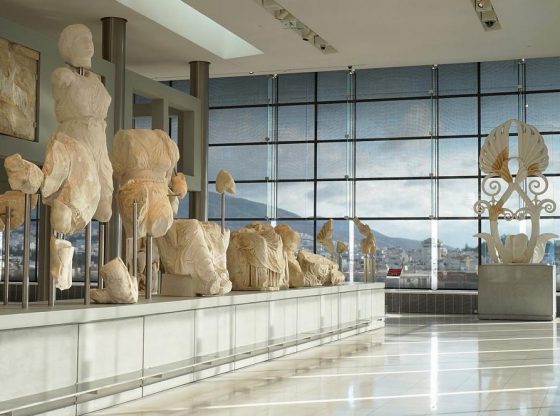The “Antikythera Youth”
Material: Bronze
Dimensions: H. 1.96 m.
Provenance: Antikythera shipwreck. From the material retrieved in 1900-1901
Date: Ca. 340-330 BC
Exhibition place: Room 28, inv. no: X 1339
The young, nude male is shown standing in a frontal pose. He is supported by the entire sole of his left leg; the right leg, bent at the knee, is set obliquely towards the right and withdrawn, with the two inner toes resting on the ground. The figure raises and extends diagonally the right arm; the left arm is lowered, relaxed, and close to the body. His head is inclined strongly right, without focusing his gaze on the object he once held in his right hand. The short hair is arranged in wavy, overlapping curls, which are rendered with particular detail and plasticity.
The “Antikythera Youth” has been variously interpreted as Apollo, a “Learned” Hermes holding a caduceus and declaiming, Heracles with club or lion-skin, a victorious athlete holding as prize a spherical lekythion, a sphere, a wreathe, a phiale, or an apple. The figure has even been considered the funerary statue of a young man.
The majority of scholars are divided between the two most prevalent views. The first, which was originally proposed by I. Svoronos, identifies the figure as the Argive hero Perseus, displaying in his right hand the head of the Gorgon Medusa, grasping her by the hair, and holding in his other hand the adamantine harpe (sickle) with which he beheaded her. This interpretation is based on comparable scenes on vases, but above all on coins and ring bezels from Roman Argos. However, the sculpture is missing requisite identifying elements such as the chlamys, winged sandals and Hades’ magical Helm of Darkness, which made the hero invisible.
The second view, initially proposed by V. Stais, identifies the Ephebe as the Trojan hero Paris, holding the Apple of Discord in his extended right hand and the bow – symbol of the slaying of Achilles – in his left. The second interpretation focuses on the characteristics that make up the multi-faceted nature of Paris as the judge of the goddesses, lover of Helen, and slayer of Achilles. Its basis is the description in Pliny (ΝΗ ΧΧΧIV 77) of a statue of Paris by the sculptor Euphranor. However, the absence of basic identifying elements of the hero, including the spear, the mantle (chlamys) and Phrygian cap, is surprising.
The statue, which is today widely regarded as an original, dates to the decade 340-330 BC. But its attribution to a specific artist finds scholars divided. An artist from the circle of the Parian sculptor Scopas, or the Corinthian sculptor Euphranor (whose works, however, are characterized by Attic influences) are among the candidates. At any rate, the majority of scholars, who consider the “Antikythera Youth” a work of the Argive-Sicyonian school of successors to Polykleitos, would prefer to attribute it the Sicyonian Kleon, a sculptor of the “third generation” of the school’s artists, on “the road towards Lysippos”.
© NATIONAL ARCHAEOLOGICAL MUSEUM, 2008-2016
http://www.namuseum.gr/object-month/2012/jan/jan12-en.html











